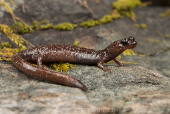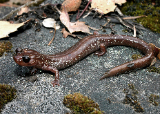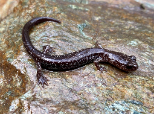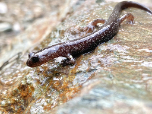Siskiyou Mountains Salamander (Plethodon stormi)
Description: Adults measure 2 3/4 to 3 inches long from snout to vent, and 4 1/3 to 5 1/2 inches in total length. A slender, elongated salamander with short limbs, nasolabial grooves, and usually 17 costal grooves with 4-5 intercostal folds between adpressed limbs. Toes are short and slightly webbed. Color is light brown to purplish brown above, with profuse whitish or yellow speckling overall, more concentrated on the limbs and sides. May show a faint light brown stripe or none at all. The belly is grayish purple with light flecks. Juveniles are black with an olive-tan stripe and a dark venter.
Habitat: Strongly associated with rocky forested areas, especially talus in older forests. The largest populations are found in heavily wooded north-facing slopes with rocky talus. Mostly found in talus slopes or rock crevices, but may move into the forest during very wet periods and reside beneath woody debris.
Range: Found in a very small area of the Siskiyou Mountains in extreme northern Siskiyou county and in the Applegate River drainage in southern Oregon.
Found in these States:
CA |
OR
Diet: Eats small invertebrates, including spiders, mites, beetles, and moths. A sit-and-wait predator, quickly jumping from a hiding spot to grab prey.
Reproduction: Little is known about the breeding behavior of this species. Reproduction is terrestrial. With the similar allopatric species P. elongtus, mating occurs in the spring, with females laying eggs in rocky underground nests in spring or early summer and brooding them until they hatch in the fall. Young develop completely in the egg, hatch fully formed and probably remain underground until the following spring.
Status: Listed as Endangered because its extent of occurrence (EOO) is 2,706 km2, it occurs in five or fewer threat-defined locations, and there is continuing decline in the extent and quality of its habitat.
»» Kingdom: Animalia - Animals
»» Phylum: Chordata - Chordates
»» Subphylum: Vertebrata - Vertebrates
»» Class: Amphibia - (Amphibians)
»» Order: Caudata - Salamanders
»» Family: Plethodontidae - Lungless Salamanders
»» Genus: Plethodon
»» Species: Plethodon stormi - Siskiyou Mountains Salamander
This article uses material from the Wikipedia article "Siskiyou Mountains Salamander", which is released under the Creative Commons Attribution-Share-Alike License 3.0. Content may have been omitted from the original, but no content has been changed or extended.
|













